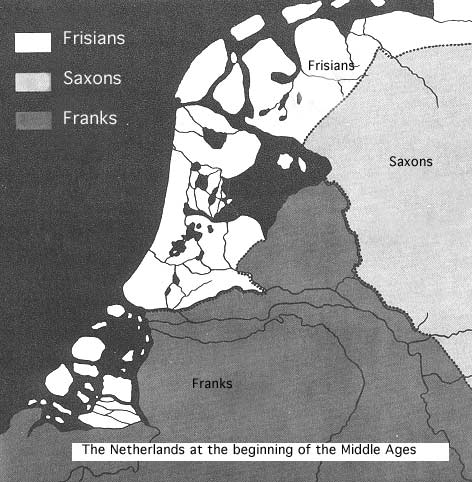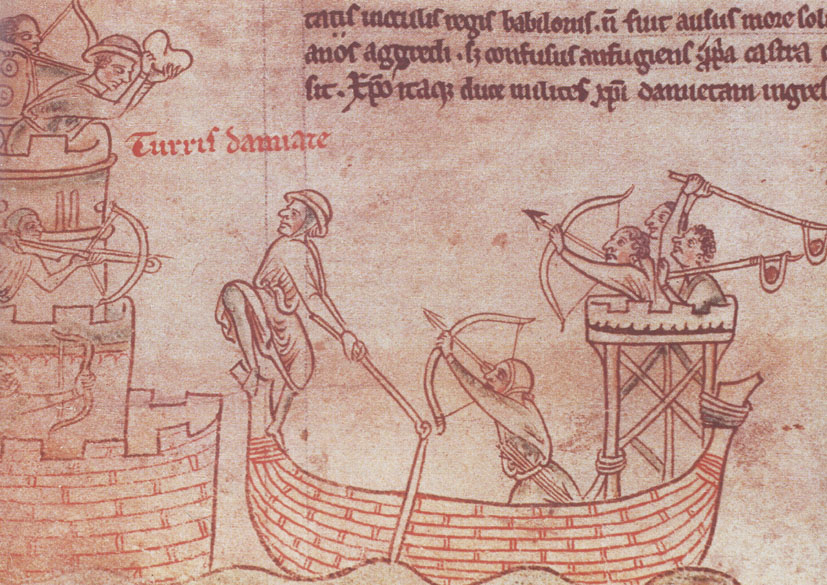The Frisians are almost always referred to collectively by contemporary chroniclers of the Crusades and few names of individual Frisian crusaders have come down to us. They generally composed a naval force in conjunction with other larger bodies of crusaders.
The first Frisians to participate in the First Crusade were part of the army which was led to the Holy Land by Godfrey of Bouillon and they are only mentioned in passing by Fulcher of Chartres, who mentions that the Frisian language was one of the many tongues spoken by the crusaders. William of Tyre, drawing his information from Fulcher, mentions Frisians as part of the troops led by Godfrey at the Siege of Antioch in 1097. According to Albert of Aix, there was also a fleet of pirates, hailing from Denmark, Frisia, and Flanders and led by Guynemer of Boulogne, who assisted Baldwin of Boulogne at Tarsus.
 Although unsubstantiated by known contemporary writings, the sixteenth- and seventeenth-century Frisian chroniclers Ocko Scharlensis and the monk Ubbo Emmius wrote in some detail of eight Frisian nobles who allegedly took up the cross and followed Peter the Hermit to the Holy Land during the Peasants' Crusade of 1096. Of the eight (Tjepke Forteman, Jarig Ludingaman, Feike Botnia, Elke and Sicco Lyauckama (cousins), Epe Hartman, Ige Galama, and Obboke (Ubbo) Hermana, son of Hessel) only two, Botnia and Sicco Lyauckama, were said to have survived the pilgrimage to Jerusalem."
Although unsubstantiated by known contemporary writings, the sixteenth- and seventeenth-century Frisian chroniclers Ocko Scharlensis and the monk Ubbo Emmius wrote in some detail of eight Frisian nobles who allegedly took up the cross and followed Peter the Hermit to the Holy Land during the Peasants' Crusade of 1096. Of the eight (Tjepke Forteman, Jarig Ludingaman, Feike Botnia, Elke and Sicco Lyauckama (cousins), Epe Hartman, Ige Galama, and Obboke (Ubbo) Hermana, son of Hessel) only two, Botnia and Sicco Lyauckama, were said to have survived the pilgrimage to Jerusalem."*) At the time the northwestern part of the present day Low Countries (the Netherlands) was referred to as "Frisia". See the map to the right from this source,
source text and illustration: Wikipedia; caption of the illustration "Frisian crusaders attack the tower of Damietta during the Fifth Crusade (from the 13th-century Chronica Majora of Matthew Paris)"
Support TemplarsNow™ by becoming a Patron, tipping us or buying one of our Reliable Books

2 comments:
According to ”Aïeul de Marie Isab[elle]de Thulden, douairière de feu Francois Joseph de Crane” the following two Dutch 'Chevaliers' participated in the Crusades:
Raijnaut van Beeck Thulden participated in the First Crusade under Godefroij the Bouillon (1092) and against the Turks in 1096.
Thirij van Beeck Thulden was said to participate in the Second Crusade and traveled to the Holy Land in 1142.
Thank your for your comment. Some remarks: the First Crusade, of which Godefroij de Bouillon was one of the leaders, started in late summer 1096 and ended with the conquest of Jerusalem in June 15, 1099. They were directed against the Seljuks from what we now call Turkey. Although, at the time of the conquest of Jerusalem, the city was under the control of the Egyptian Fatimids, who were also enimies of the Seljuks. The Second Crusade was between 1145–1149. This does not mean that no knights travelled to the Holy land for a pilgrimage in other years on private trips. What we now call "crusades" being in fact collective, organized armed group pilgimages. In fact, at the time of the First Crusade, "journey", and peregrinatio, or "pilgrimage" were used for the campaign we now call Crusade.
Post a Comment